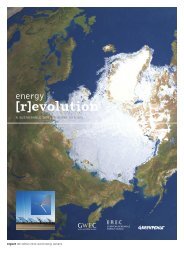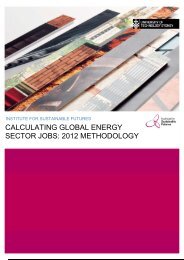download the mexico energy revolution scenario
download the mexico energy revolution scenario
download the mexico energy revolution scenario
Create successful ePaper yourself
Turn your PDF publications into a flip-book with our unique Google optimized e-Paper software.
WORLD ENERGY [R]EVOLUTION<br />
A SUSTAINABLE ENERGY OUTLOOK<br />
2<br />
implementing <strong>the</strong> <strong>energy</strong> [r]evolution | GREENHOUSE DEVELOPMENT RIGHTS<br />
Based on <strong>the</strong> Energy [R]evolution pathway for <strong>the</strong> three OECD<br />
regions <strong>the</strong> total domestic emissions would add up to 9.9 GtCO2<br />
by 2020 and 7.2 GtCO2 by 2030<br />
Under <strong>the</strong> GDR scheme <strong>the</strong> OECD regions would have an emissions<br />
budget of 8.14 GtCO2 by 2020 and 2.9 GtCO2 by 2030. Therefore <strong>the</strong><br />
richer nations have to finance <strong>the</strong> saving of 1.7 GtCO2 by 2020 and<br />
4.3 GtCO2 by 2030 in non-OECD countries.<br />
The non-OECD countries would in aggregate see <strong>the</strong>ir emissions<br />
allocation rise from 195% of 1990 levels in 2020 to 200% in 2030.<br />
In MtCO2, China’s emissions allocation would rise from about 8,200<br />
in 2015 to about 8,500 in 2020 and grow only slightly more by<br />
2030. India by contrast would see its allocation rise from 1,600<br />
MtCO2 today to about 2,000 by 2020 and 2,800 MtCO2 in 2030.<br />
Within <strong>the</strong> OECD, <strong>the</strong> US allocation would fall to 52% of 1990<br />
levels by 2020 and 2% by 2030, while <strong>the</strong> EU’s allocation would fall<br />
from 84% today to 33% of 1990 levels in 2020 and -3% of 1990<br />
levels by 2030. (A negative emissions allocation is simply a<br />
requirement to buy a larger quantity of emission permits/support a<br />
larger amount of mitigation internationally.)<br />
Under <strong>the</strong> advanced Energy [R]evolution <strong>scenario</strong>, which has global<br />
emissions falling to 25 GtCO2 in 2020, instead of 27 GtCO2 in <strong>the</strong><br />
basic version, and <strong>the</strong>n to 18 GtCO2 instead of 22 GtCO2 in 2030,<br />
reductions are correspondingly steeper. The OECD countries’<br />
allocation of emissions falls to 19% of 1990 levels in 2020 and -<br />
22% in 2030, with <strong>the</strong> US share being 20% and -24% respectively<br />
and <strong>the</strong> EU’s share 12% and -22%. China’s emissions allocation<br />
peaks at 8,300 MtCO2 (instead of 8,500 under <strong>the</strong> basic <strong>scenario</strong>)<br />
and falls to 7,300 MtCO2 by 2030; India, however, changes little<br />
from its allowances under <strong>the</strong> less stringent global pathway.<br />
For an interesting comparison in terms of relatively wealthy<br />
“developing” countries, which are currently completely excluded from<br />
binding targets under <strong>the</strong> Kyoto protocol, consider Brazil and Mexico;<br />
both see <strong>the</strong>ir allocation falling immediately below <strong>the</strong>ir 2010 levels.<br />
In <strong>the</strong> Energy [R]evolution <strong>scenario</strong>, <strong>the</strong> drop is about a 15%<br />
reduction below 2010 levels by 2020; in <strong>the</strong> advanced <strong>scenario</strong>,<br />
<strong>the</strong> drop is about a 30% reduction below 2010 levels.<br />
Table 2.7 presents an overview of <strong>the</strong> CO2 emission allocations by<br />
country and/or region based on <strong>the</strong> global Energy [R]evolution<br />
pathway towards a level of 27 GtCO2 in 2020 and 21.9 GtCO2 in<br />
2030. The advanced version shown in Table 2.8 has a stricter<br />
reduction pathway, falling to 18.3 GtCO2 by 2030, a bit more than<br />
ten years ahead of <strong>the</strong> basic <strong>scenario</strong>. The GDR system allocates <strong>the</strong><br />
same emission allocations for each country under <strong>the</strong> advanced<br />
Energy [R]evolution pathway, but this <strong>scenario</strong> also results in a faster<br />
uptake of renewable <strong>energy</strong>, enabling developing countries to leapfrog<br />
from conventional to renewables faster. This pathway might also<br />
reduce stranded investments resulting from closed fossil fuel power<br />
stations, as developing countries will be able to build up <strong>the</strong> <strong>energy</strong><br />
infrastructure with new technologies from <strong>the</strong> very beginning.<br />
In total, all <strong>the</strong> OECD countries will have cumulative emissions<br />
allocations between 1990 and 2030 of 8.14 GtCO2 and 7.35 GtCO2<br />
under <strong>the</strong> advanced Energy [R]evolution <strong>scenario</strong>. The <strong>scenario</strong>s<br />
show that 21% (basic version) or 27% (advanced) of those<br />
emission reductions will have to come from international actions, as<br />
domestic emissions are still too high. In summary, <strong>the</strong> OECD<br />
countries will have to finance a saving of 45 GtCO2 for non-OECD<br />
countries. A possible mechanism to support <strong>the</strong> introduction of<br />
renewable power generation in those countries - crucial to <strong>the</strong><br />
Energy [R]evolution <strong>scenario</strong>s - would be <strong>the</strong> feed-in tariff support<br />
system described below.<br />
applying GDR to <strong>the</strong> <strong>energy</strong> [r]evolution<br />
It is obvious that, given <strong>the</strong> huge responsibility and large capacity<br />
of industrialised countries, <strong>the</strong>y have a high RCI. Their<br />
responsibility for implementing emission reductions should <strong>the</strong>refore<br />
go well beyond <strong>the</strong> domestic reductions <strong>the</strong>y can achieve by<br />
implementing <strong>the</strong> Energy [R]evolution. Tables 2.7 and 2.8 show <strong>the</strong><br />
difference between <strong>the</strong>ir emissions under <strong>the</strong> two ER <strong>scenario</strong>s and<br />
<strong>the</strong> emission reductions <strong>the</strong>y would be responsible for if <strong>the</strong> RCI is<br />
used to distribute <strong>the</strong>ir global obligations more equitably.<br />
The difference between <strong>the</strong>ir domestic emissions in <strong>the</strong> ER <strong>scenario</strong>s<br />
and <strong>the</strong> levels under <strong>the</strong> RCI system defines <strong>the</strong> responsibility that<br />
<strong>the</strong>se countries will have to fund <strong>the</strong> implementation of <strong>the</strong> Energy<br />
[R]evolution <strong>scenario</strong> in developing countries<br />
28



![Energy [R]evolution - European Commission](https://img.yumpu.com/49109324/1/184x260/energy-revolution-european-commission.jpg?quality=85)


![5905 gp [eu rev]csfr4.qxd - Energy [R]evolution](https://img.yumpu.com/42305023/1/184x260/5905-gp-eu-revcsfr4qxd-energy-revolution.jpg?quality=85)


![5905 gp [eu rev]csfr4.qxd - Energy [R]evolution](https://img.yumpu.com/28729264/1/184x260/5905-gp-eu-revcsfr4qxd-energy-revolution.jpg?quality=85)